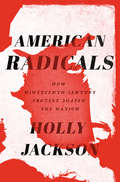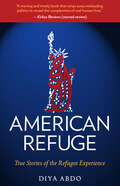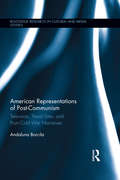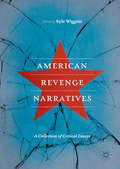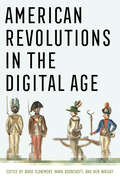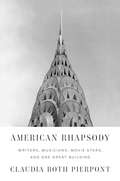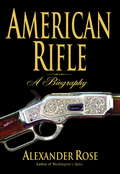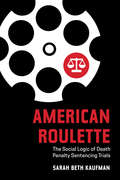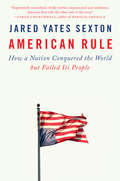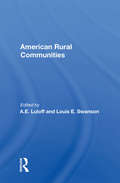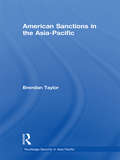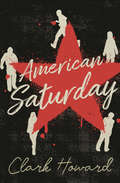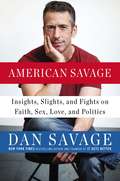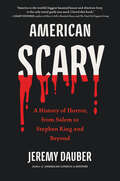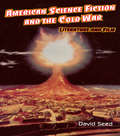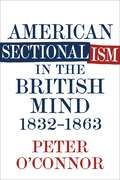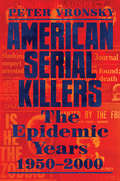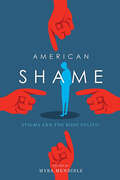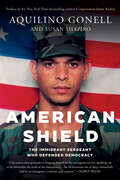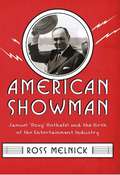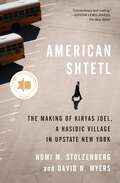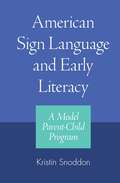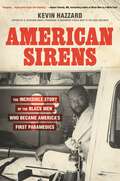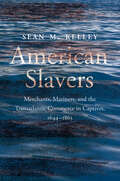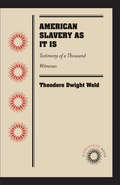- Table View
- List View
American Radicals: How Nineteenth-Century Protest Shaped the Nation
by Holly JacksonA dynamic, timely history of nineteenth-century activists—free-lovers and socialists, abolitionists and vigilantes—and the social revolution they sparked in the turbulent Civil War era“In the tradition of Howard Zinn’s people’s histories, American Radicals reveals a forgotten yet inspiring past.”—Megan Marshall, Pulitzer Prize–winning author of Margaret Fuller: A New American Life and Elizabeth Bishop: A Miracle for Breakfast On July 4, 1826, as Americans lit firecrackers to celebrate the country’s fiftieth birthday, both John Adams and Thomas Jefferson were on their deathbeds. They would leave behind a groundbreaking political system and a growing economy—as well as the glaring inequalities that had undermined the American experiment from its beginning. The young nation had outlived the men who made it, but could it survive intensifying divisions over the very meaning of the land of the free? A new network of dissent—connecting firebrands and agitators on pastoral communes, in urban mobs, and in genteel parlors across the nation—vowed to finish the revolution they claimed the Founding Fathers had only begun. They were men and women, black and white, fiercely devoted to causes that pitted them against mainstream America even while they fought to preserve the nation’s founding ideals: the brilliant heiress Frances Wright, whose shocking critiques of religion and the institution of marriage led to calls for her arrest; the radical Bostonian William Lloyd Garrison, whose commitment to nonviolence would be tested as the conflict over slavery pushed the nation to its breaking point; the Philadelphia businessman James Forten, who presided over the first mass political protest of free African Americans; Marx Lazarus, a vegan from Alabama whose calls for sexual liberation masked a dark secret; black nationalist Martin Delany, the would-be founding father of a West African colony who secretly supported John Brown’s treasonous raid on Harpers Ferry—only to ally himself with Southern Confederates after the Civil War. Though largely forgotten today, these figures were enormously influential in the pivotal period flanking the war, their lives and work entwined with reformers like Frederick Douglass, Elizabeth Cady Stanton, and Henry David Thoreau, as well as iconic leaders like Abraham Lincoln. Jackson writes them back into the story of the nation’s most formative and perilous era in all their heroism, outlandishness, and tragic shortcomings. The result is a surprising, panoramic work of narrative history, one that offers important lessons for today.
American Refuge: True Stories of the Refugee Experience (Truth to Power)
by Diya Abdo&“A moving and timely book that strips away misleading politics to reveal the complexities of real human lives." — Kirkus Reviews (starred review)A provocative, conversation-sparking exploration of refugee experiences told in their own words, for readers of Karla Cornejo Villavicencio&’s The Undocumented Americans and Viet Thanh NguyenForced to leave their homes, they came to America...In this intimate and eye-opening book, Diya Abdo--daughter of refugees, U.S. immigrant, English professor, and activist—shares the stories of seven refugees. Coming from around the world, they&’re welcomed by Every Campus A Refuge (ECAR), an organization Diya founded to leverage existing resources at colleges to provide temporary shelter to refugee families.Bookended by Diya&’s powerful essay "Radical Hospitality" and the inspiring coda &“Names and Numbers,&” each chapter weaves the individual stories into a powerful journey along a common theme: Life Before (&“The Body Leaves its Soul Behind&”) The Moment of Rupture (&“Proof and Persecution&”) The Journey (&“Right Next Door&”) Arrival/Resettlement (&“Back to the Margins&”) A Few Years Later (&“From Camp to Campus&”) The lives explored in American Refuge include the artist who, before he created the illustration on the cover of this book, narrowly escaped two assassination attempts in Iraq and now works at Tyson cutting chicken.We learn that these refugees from Burma, Burundi, Iraq, Palestine, Syria, and Uganda lived in homes they loved, left against their will, moved to countries without access or rights, and were among the 1% of the "lucky" few to resettle after a long wait, almost certain never to return to the homes they never wanted to leave. We learn that anybody, at any time, can become a refugee.
American Representations of Post-Communism: Television, Travel Sites, and Post-Cold War Narratives (Routledge Research in Cultural and Media Studies)
by Andaluna BorcilaWith the televised events of 1989, territories of Eastern and Central Europe that had been marked as impenetrable and inaccessible to the Western gaze exploded into visibility. As the narratives of the Cold War crumbled, new narratives emerged and new geographies were produced on and by American television. Using an understudied archive of American news broadcasts, and tracing their flashes and echoes through travel guides and narratives of return written by Eastern European-Americans, this book explores American ways of seeing and mapping communism’s disintegration and the narratives articulated around post-communist sites and subjects.
American Revenge Narratives: A Collection of Critical Essays
by Kyle WigginsAmerican Revenge Narratives critically examines the nation’s vengeful storytelling tradition. With essays on late twentieth and twenty-first century fiction, film, and television, it maps the coordinates of the revenge genre’s contemporary reinvention across American culture. By surveying American revenge narratives, this book measures how contemporary payback plots appraise the nation’s political, social, and economic inequities. The volume’s essays collectively make the case that retribution is a defining theme of post-war American culture and an artistic vehicle for critique. In another sense, this book presents a scholarly coming to terms with the nation’s love for vengeance. By investigating recent iterations of an ancient genre, contributors explore how the revenge narrative evolves and thrives within American literary and filmic imagination. Taken together, the book’s diverse chapters attempt to understand American culture’s seemingly inexhaustible production of vengeful tales.
American Revolutions in the Digital Age
by Ben Wright Mark Boonshoft Nora SlonimskyThe interdisciplinary essays in American Revolutions in the Digital Age explore what digital tools can tell us about the late eighteenth- and early nineteenth-century United States and reveal how an understanding of the American past can make sense of our digital present. By employing a host of innovative digital research methods, these authors challenge long-held assumptions about the American past. In addition, this collection uniquely demonstrates how contemporary anxieties about an array of topics, including media disinformation, patriarchy, economic inequality, and public memory, can be better understood through careful considerations of early American history.Open Access edition funded by Iona University
American Rhapsody: Writers, Musicians, Movie Stars, and One Great Building
by Claudia Roth PierpontRanging from the shattered gentility of Edith Wharton's heroines to racial confrontation in the songs of Nina Simone, American Rhapsody presents a kaleidoscopic story of the creation of a culture. Here is a series of deeply involving portraits of American artists and innovators who have helped to shape the country in the modern age. Claudia Roth Pierpont expertly mixes biography and criticism, history and reportage, to bring these portraits to life and to link them in surprising ways. It isn't far from Wharton's brave new women to F. Scott Fitzgerald's giddy flappers, and on to the big-screen command of Katharine Hepburn and the dangerous dames of Dashiell Hammett's hard-boiled world. The improvisatory jazziness of George Gershwin's Rhapsody in Blue has its counterpart in the great jazz baby of the New York skyline, the Chrysler Building. Questions of an American acting style are traced from Orson Welles to Marlon Brando, while the new American painting emerges in the gallery of Peggy Guggenheim. And we trace the arc of racial progress from Bert Williams's blackface performances to James Baldwin's warning of the fire next time, however slow and bitter and anguished this progress may be. American Rhapsody offers a history of twentieth-century American invention and genius. It is about the joy and profit of being a heterogeneous people, and the immense difficulty of this human experiment.
American Rifle: A Biography
by Alexander RoseGeorge Washington insisted that his portrait be painted with one. Daniel Boone created a legend with one. Abraham Lincoln shot them on the White House lawn. And Teddy Roosevelt had his specially customized. Now, in this first-of-its-kind book, historian Alexander Rose delivers a colorful, engrossing biography of an American icon: the rifle. Drawing on the words of soldiers, inventors, and presidents, based on extensive new research, and encompassing the Revolution to the present day,American Rifleis a balanced, wonderfully entertaining history of this most essential firearm and its place in American culture. In the eighteenth century American soldiers discovered that they no longer had to fight in Europe's time-honored way. With the evolution of the famed "Kentucky" Rifle--a weapon slow to load but devastatingly accurate in the hands of a master--a new era of warfare dawned, heralding the birth of the American individualist in battle. In this spirited narrative, Alexander Rose reveals the hidden connections between the rifle's development and our nation's history. We witness the high-stakes international competition to produce the most potent gunpowder . . . how the mysterious arts of metallurgy, gunsmithing, and mass production played vital roles in the creation of American economic supremacy . . . and the ways in which bitter infighting between rival arms makers shaped diplomacy and influenced the most momentous decisions in American history. And we learn why advances in rifle technology and ammunition triggered revolutions in military tactics, how ballistics tests--frequently bizarre--were secretly conducted, and which firearms determined the course of entire wars. From physics to geopolitics, from frontiersmen to the birth of the National Rifle Association, from the battles of the Revolution to the war in Iraq,American Rifleis a must read for history buffs, gun collectors, soldiers--and anyone who seeks to understand the dynamic relationship between the rifle and this nation's history.
American Roulette: The Social Logic of Death Penalty Sentencing Trials
by Sarah Beth KaufmanAs the death penalty clings to life in many states and dies off in others, this first-of-its-kind ethnography takes readers inside capital trials across the United States. Sarah Beth Kaufman draws on years of ethnographic and documentary research, including hundreds of hours of courtroom observation in seven states, interviews with participants, and analyses of newspaper coverage to reveal how the American justice system decides who deserves the most extreme punishment. The "super due process" accorded capital sentencing by the United States Supreme Court is the system’s best attempt at individuated sentencing. Resources not seen in most other parts of the criminal justice system, such as jurors and psychological experts, are required in capital trials, yet even these cannot create the conditions of morality or justice. Kaufman demonstrates that capital trials ultimately depend on performance and politics, resulting in the enactment of deep biases and utter capriciousness. American Roulette contends that the liberal, democratic ideals of criminal punishment cannot be enacted in the current criminal justice system, even under the most controlled circumstances.
American Rule: How a Nation Conquered the World but Failed Its People
by Jared Yates SextonFrom writer and political analyst Jared Yates Sexton comes a journey through the history of the United States, from the nation&’s founding to the twenty-first century, which examines and debunks the American myths we've always told ourselves. In recent years, Americans have faced a deluge of horrifying developments in politics and culture: stolen elections, fascist rallies, families torn apart and locked away. A common refrain erupts at each new atrocity: This isn't who we are. In American Rule, Jared Yates Sexton upends those convenient fictions by laying bare the foundational myths at the heart of our collective American imagination. From the very origins of this nation, Americans in power have abused and subjugated others; enabling that corruption are the many myths of American exceptionalism and steadfast values, which are fed to the public and repeated across generations. Working through each era of American growth and change, Sexton weaves together the origins and perpetuation of these narratives still in the public memory, and the acts we have chosen to forget. Stirring, deeply researched, and disturbingly familiar, American Rule is a call to examine our own misconceptions of what it means, and has always meant, to be an American.
American Rural Communities
by A. E. Luloff Louis E. SwansonThis book is dedicated to the people of rural America whose struggle to make community meaningful provides important lessons. It includes the contributors' prescription for the 1990s that calls for a renewal of action, development, and leadership on the part of local citizens and civic leaders.
American Sanctions in the Asia-Pacific (Routledge Security in Asia Pacific Series #Vol. 14)
by Brendan TaylorSanctions are a persistent – many would argue increasingly central – component of American efforts to shape foreign policy outcomes in the Asia-Pacific. The use of sanctions in the context of two of the most pressing regional security issues currently on Washington’s radar – the ongoing North Korean nuclear crisis and the management of China’s emergence – clearly reaffirms this pattern. This book provides the first comprehensive treatment of US sanctions policy in the Asia-Pacific. Using the Bill Clinton and George W. Bush presidencies as a basis for comparison, it examines nine prominent episodes involving the US use of sanctions toward countries in this economically and strategically vital part of the world. In each case it addresses the reasons why sanctions were employed in the first place, the precise nature of sanctions and how they operated in practice, before evaluating their effectiveness. Finally, it identifies common trends that emerge from this analysis and draws out practical implications for US sanctions policy, in particular when and how the US can – and cannot – optimally use sanctions in an Asia-Pacific context.
American Saturday
by Clark HowardA &“vividly written&” account of the bloody 1971 San Quentin riot by the Edgar Award–winning author of Zebra and Six Against the Rock (Kirkus Reviews). American Saturday traces one man&’s path from the slums of Chicago to the California state prison where he embraced radicalism, was charged for the murder of a corrections officer, and eventually, was gunned down during the violent chaos following a failed escape attempt. This chilling account of an infamous prison riot comes from a writer who has been called &“a superlative storyteller&” (Publishers Weekly). &“The Saturday was August 21, 1971 and the headline read &‘George Jackson, 5 Others Slain in San Quentin.&’ Howard&’s account traces the careers of the inmates and guards whose lives converged and ended that day, but focuses on the pivotal figure of Jackson himself, whose botched escape attempt—just before his scheduled trial in the &‘Soledad Brothers&’ murder case—led to a gory riot in which three guards, two other inmates, and Jackson himself were killed. . . . Extensively researched and vividly written.&” —Kirkus Reviews
American Savage: Insights, Slights, and Fights on Faith, Sex, Love, and Politics
by Dan SavageOn the heels of his Emmy-winning It Gets Better campaign, columnist and provocateur Dan Savage weighs in on such diverse issues as healthcare, gun control, and marriage equality with characteristic straight talk and humor. <P> Dan Savage has always had a loyal audience, thanks to his syndicated sex-advice column "Savage Love," but since the incredible global success of his It Gets Better project-his book of the same name was a New York Times bestseller-his profile has skyrocketed. In addition, he's written for The New York Times, Rolling Stone, The Onion, GQ, The Guardian, Salon. com, and countless other widely read publications. Savage is recognized as someone whose opinions about our culture, politics, and society should not only be listened to but taken seriously. <P> Now, in American Savage, he writes on topics ranging from marriage, parenting, and the gay agenda to the Catholic Church and sex education. .
American Scary: A History of Horror, from Salem to Stephen King and Beyond
by Jeremy Dauber"America is the world's biggest haunted house and American Scary is the only travel guide you need. I loved this book." —Grady Hendrix, New York Times bestselling author of How to Sell a Haunted House and The Final Girl Support GroupFrom the acclaimed author of American Comics comes a sweeping and entertaining narrative that details the rise and enduring grip of horror in American literature, and, ultimately, culture—from the taut, terrifying stories of Edgar Allan Poe to the grisly, lingering films of Jordan Peele America is held captive by horror stories. They flicker on the screen of a darkened movie theater and are shared around the campfire. They blare out in tabloid true-crime headlines, and in the worried voices of local news anchors. They are consumed, virally, on the phones in our pockets. Like the victims in any slasher movie worth its salt, we can&’t escape the thrall of scary stories. In American Scary, noted cultural historian and Columbia professor Jeremy Dauber takes the reader to the startling origins of horror in the United States. Dauber draws a captivating through line that ties historical influences ranging from the Salem witch trials and enslaved-person narratives directly to the body of work we more closely associate with horror today: the weird tales of H. P. Lovecraft, the lingering fiction of Shirley Jackson, the disquieting films of Alfred Hitchcock, the up-all-night stories of Stephen King, and the gripping critiques of Jordan Peele. With the dexterous weave of insight and style that have made him one of America&’s leading historians of popular culture, Dauber makes the haunting case that horror reveals the true depths of the American mind.
American Science Fiction and the Cold War: Literature and Film (America In The 20th/21st Century Ser. #Vol. 3)
by David SeedFirst Published in 1999. Routledge is an imprint of Taylor & Francis, an informa company.
American Sectionalism in the British Mind, 1832-1863
by Peter O'ConnorIn American Sectionalism in the British Mind, 1832–1863, Peter O’Connor uses an innovative interdisciplinary approach to provide a corrective to simplified interpretations of British attitudes towards the United States during the antebellum and early Civil War periods. Exploring the many complexities of transatlantic politics and culture, O’Connor examines developing British ideas about U.S. sectionalism, from the abolition of slavery in the British Empire and the Nullification Crisis in South Carolina to the Civil War.Through a close reading of travelogues, fictional accounts, newspaper reports, and personal papers, O’Connor argues that the British literate population had a longstanding familiarity with U.S. sectionalism and with the complex identities of the North and South. As a consequence of their engagement with published accounts of America produced in the decades leading up to the Civil War, the British populace approached the conflict through these preexisting notions.O’Connor reveals even antislavery commentators tended to criticize slavery in the abstract and to highlight elements of the system that they believed compared favorably to the condition of free blacks in the North. As a result, the British saw slavery in the U.S. in national as opposed to sectional terms, which collapsed the moral division between North and South. O’Connor argues that the British identified three regions within America—the British Cavalier South, the British Puritan New England, and the ethnically heterogeneous New York and Pennsylvania region—and demonstrates how the apparent lack of a national American culture prepared Britons for the idea of disunity within the U.S. He then goes on to highlight how British commentators engaged with American debates over political culture, political policy, and states’ rights. In doing so, he reveals the complexity of the British understanding of American sectionalism in the antebellum era and its consequences for British public opinion during the Civil War.American Sectionalism in the British Mind, 1832–1863 re-conceptualizes our understanding of British engagements with the United States during the mid-nineteenth century, offering a new explanation of how the British understood America in the antebellum and Civil War eras.
American Serial Killers: The Epidemic Years 1950-2000
by Peter VronskyFans of Mindhunter and true crime podcasts will devour these chilling stories of serial killers from the American "Golden Age" (1950-2000). With books like Serial Killers, Female Serial Killers and Sons of Cain, Peter Vronsky has established himself as the foremost expert on the history of serial killers. In this first definitive history of the "Golden Age" of American serial murder, when the number and body count of serial killers exploded, Vronsky tells the stories of the most unusual and prominent serial killings from the 1950s to the early twenty-first century. From Ted Bundy to the Golden State Killer, our fascination with these classic serial killers seems to grow by the day. American Serial Killers gives true crime junkies what they crave, with both perennial favorites (Ed Kemper, Jeffrey Dahmer) and lesser-known cases (Melvin Rees, Harvey Glatman).
American Shame: Stigma and the Body Politic
by Myra MendibleOn any given day in America's news cycle, stories and images of disgraced politicians and celebrities solicit our moral indignation, their misdeeds fueling a lucrative economy of shame and scandal. Shame is one of the most coercive, painful, and intriguing of human emotions. Only in recent years has interest in shame extended beyond a focus on the subjective experience of this emotion and its psychological effects. The essays collected here consider the role of shame as cultural practice and examine ways that public shaming practices enforce conformity and group coherence. Addressing abortion, mental illness, suicide, immigration, and body image among other issues, this volume calls attention to the ways shaming practices create and police social boundaries; how shaming speech is endorsed, judged, or challenged by various groups; and the distinct ways that shame is encoded and embodied in a nation that prides itself on individualism, diversity, and exceptionalism. Examining shame through a prism of race, sexuality, ethnicity, and gender, these provocative essays offer a broader understanding of how America's discourse of shame helps to define its people as citizens, spectators, consumers, and moral actors.
American Shield: The Immigrant Sergeant Who Defended Democracy
by Susan Shapiro Aquilino Gonell&“American Shield is an all-American tale of duty and determination—beautifully told by an immigrant, a veteran, and a patriot.&” —Nancy Pelosi, Speaker Emerita of the United States House of RepresentativesSet against the extraordinary events of January 6, 2021, Aquilino Gonell&’s inspirational memoir is rooted in the joys and struggles of the immigrant experience that have long defined the American experimentAquilino Gonell came to the United States from the Dominican Republic as a young boy. Although he spoke no English, he dedicated himself to his adopted land, striving for the American dream. Determined to be a success story, he joined the army to pay for college. He saw action in Iraq and returned home with PTSD. Believing in the promise of our government, he focused on healing himself and supporting his family. His hard work paid off when he landed a coveted position with the United States Capitol Police and rose to the rank of sergeant.January 6, 2021, changed everything. When insurrectionists stormed the Capitol, Gonell bravely faced down the mob attempting to thwart the peaceful transfer of power. The brutal injuries he sustained that day would end his career in law enforcement. But when some of the very people he put his life on the line to protect downplayed or denied the truth of that day, he chose to speak out against the injustice done to him and the country. Chronicling what it means to live a life of conviction, one that adheres to the best ideas of our democracy, American Shield is a bold testament to the power of truth, justice, and accountability from a highly decorated officer and immigrant who exemplifies the greatest aspirations of a grateful nation.
American Showman: Samuel "Roxy" Rothafel and the Birth of the Entertainment Industry, 1908–1935 (Film and Culture Series)
by Ross MelnickSamuel "Roxy" Rothafel (1882–1936) built an influential and prolific career as film exhibitor, stage producer, radio broadcaster, musical arranger, theater manager, war propagandist, and international celebrity. He helped engineer the integration of film, music, and live performance in silent film exhibition; scored early Fox Movietone films such as Sunrise (1927); pioneered the convergence of film, broadcasting, and music publishing and recording in the 1920s; and helped movies and moviegoing become the dominant form of mass entertainment between the world wars. <P><P>The first book devoted to Rothafel's multifaceted career, American Showman examines his role as the key purveyor of a new film exhibition aesthetic that appropriated legitimate theater, opera, ballet, and classical music to attract multi-class audiences. Roxy scored motion pictures, produced enormous stage shows, managed many of New York's most important movie houses, directed and/or edited propaganda films for the American war effort, produced short and feature-length films, exhibited foreign, documentary, independent, and avant-garde motion pictures, and expanded the conception of mainstream, commercial cinema. He was also one of the chief creators of the radio variety program, pioneering radio broadcasting, promotions, and tours.The producers and promoters of distinct themes and styles, showmen like Roxy profoundly remade the moviegoing experience, turning the deluxe motion picture theater into a venue for exhibiting and producing live and recorded entertainment. Roxy's interest in media convergence also reflects a larger moment in which the entertainment industry began to create brands and franchises, exploit them through content release "events," and give rise to feature films, soundtracks, broadcasts, live performances, and related consumer products. Regularly cited as one of the twelve most important figures in the film and radio industries, Roxy was instrumental to the development of film exhibition and commercial broadcasting, musical accompaniment, and a new, convergent entertainment industry.
American Shtetl: The Making of Kiryas Joel, a Hasidic Village in Upstate New York
by David N. Myers Nomi M. StolzenbergA compelling account of how a group of Hasidic Jews established its own local government on American soilSettled in the mid-1970s by a small contingent of Hasidic families, Kiryas Joel is an American town with few parallels in Jewish history—but many precedents among religious communities in the United States. This book tells the story of how this group of pious, Yiddish-speaking Jews has grown to become a thriving insular enclave and a powerful local government in upstate New York. While rejecting the norms of mainstream American society, Kiryas Joel has been stunningly successful in creating a world apart by using the very instruments of secular political and legal power that it disavows.Nomi Stolzenberg and David Myers paint a richly textured portrait of daily life in Kiryas Joel, exploring the community's guiding religious, social, and economic norms. They delve into the roots of Satmar Hasidism and its charismatic founder, Rebbe Joel Teitelbaum, following his journey from nineteenth-century Hungary to post–World War II Brooklyn, where he dreamed of founding an ideal Jewish town modeled on the shtetls of eastern Europe. Stolzenberg and Myers chart the rise of Kiryas Joel as an official municipality with its own elected local government. They show how constant legal and political battles defined and even bolstered the community, whose very success has coincided with the rise of political conservatism and multiculturalism in American society over the past forty years.Timely and accessible, American Shtetl unravels the strands of cultural and legal conflict that gave rise to one of the most vibrant religious communities in America, and reveals a way of life shaped by both self-segregation and unwitting assimilation.
American Sign Language and Early Literacy: A Model Parent-Child Program
by Kristin SnoddonThe usual definition of the term "literacy" generally corresponds with mastering the reading and writing of a spoken language. This narrow scope often engenders unsubstantiated claims that print literacy alone leads to, among other so-called higher-order thinking skills, logical and rational thinking and the abstract use of language. Thus, the importance of literacy for deaf children in American Sign Language (ASL) is marginalized, asserts author Kristin Snoddon in her new book American Sign Language and Early Literacy: A Model Parent-Child Program. As a contrast, Snoddon describes conducting an ethnographic, action study of the ASL Parent-Child Mother Goose program, provided by a Deaf service agency in Ontario, Canada to teach ASL literacy to deaf children. According to current scholarship, literacy is achieved through primary discourse shared with parents and other intimates, which establishes a child's initial sense of identity, culture, and vernacular language. Secondary discourse derives from outside agents and interaction, such as expanding an individual's literacy to other languages. Snoddon writes that the focus of the ASL Parent-Child Mother Goose program is on teaching ASL through rhymes and stories and some facets of the culture of Deaf ASL users. This focus enabled hearing parents to impart first-language acquisition and socialization to their deaf children in a more natural primary discourse as if the parents were Deaf themselves. At the same time, hearing parents experience secondary discourses through their exposure to ASL and Deaf culture. Snoddon also comments on current infant hearing screening and early intervention and the gaps in these services. She discusses gatekeeper individuals and institutions that restrict access to ASL for young Deaf children and their families. Finally, she reports on public resources for supporting ASL literacy and the implications of her findings regarding the benefits of early ASL literacy programming for Deaf children and their families.
American Sirens: The Incredible Story of the Black Men Who Became America's First Paramedics
by Kevin HazzardThe extraordinary story of an unjustly forgotten group of Black men in Pittsburgh who became the first paramedics in America, saving lives and changing the course of emergency medicine around the world Until the 1970s, if you suffered a medical crisis, your chances of survival were minimal. A 9-1-1 call might bring police or even the local funeral home. But that all changed with Freedom House EMS in Pittsburgh, a group of Black men who became America&’s first paramedics and set the gold standard for emergency medicine around the world, only to have their story and their legacy erased—until now.In American Sirens, acclaimed journalist and paramedic Kevin Hazzard tells the dramatic story of how a group of young, undereducated Black men forged a new frontier of healthcare. He follows a rich cast of characters that includes John Moon, an orphan who found his calling as a paramedic; Peter Safar, the Nobel Prize-nominated physician who invented CPR and realized his vision for a trained ambulance service; and Nancy Caroline, the idealistic young doctor who turned a scrappy team into an international leader. At every turn, Freedom House battled racism—from the community, the police, and the government. Their job was grueling, the rules made up as they went along, their mandate nearly impossible—and yet despite the long odds and fierce opposition, they succeeded spectacularly. Never-before revealed in full, this is a rich and troubling hidden history of the Black origins of America&’s paramedics, a special band of dedicated essential workers, who stand ready to serve day and night on the line between life and death for every one of us.
American Slavers: Merchants, Mariners, and the Transatlantic Commerce in Captives, 1644-1865
by Sean M. KelleyThe first telling of the unknown story of America’s two-hundred-year history as a slave-trading nation A total of 305,000 enslaved Africans arrived in the New World aboard American vessels over a span of two hundred years as American merchants and mariners sailed to Africa and to the Caribbean to acquire and sell captives. Using exhaustive archival research, including many collections that have never been used before, historian Sean M. Kelley argues that slave trading needs to be seen as integral to the larger story of American slavery. Engaging with both African and American history and addressing the trade over time, Kelley examines the experience of captivity, drawing on more than a hundred African narratives to offer a portrait of enslavement in the regions of Africa frequented by American ships. Kelley also provides a social history of the two American ports where slave trading was most intensive, Newport and Bristol, Rhode Island. In telling this tragic, brutal, and largely unknown story, Kelley corrects many misconceptions while leaving no doubt that Americans were a nation of slave traders.
American Slavery As It Is
by Theodore Dwight WeldCompiled by a prominent abolitionist Theodore Dwight Weld, American Slavery As It Is combines information taken from witnesses, and from active and former slave owners, to generate a condemnation of slavery from both those who observed it and those who perpetuated it. The narrative describes the appalling day-to-day conditions of the over 2,700,000 men, women and children in slavery in the United States. Weld demonstrates how even prisoners--in the United States and in other countries--were significantly better fed than American slaves. Readers will find one of the most meticulous records of slave life available in this text. Unlike personal slave narratives, which focus on a single man or woman's experience, American Slavery details the overall conditions of slaves across multiple states and several years. A DOCSOUTH BOOK. This collaboration between UNC Press and the University of North Carolina at Chapel Hill Library brings selected classic works from the digital library of Documenting the American South back into print. DocSouth Books uses the latest digital technologies to make these works available as downloadable e-books or print-on-demand publications. DocSouth Books are unaltered from the original publication, providing affordable and easily accessible editions to a new generation of scholars, students, and general readers.
